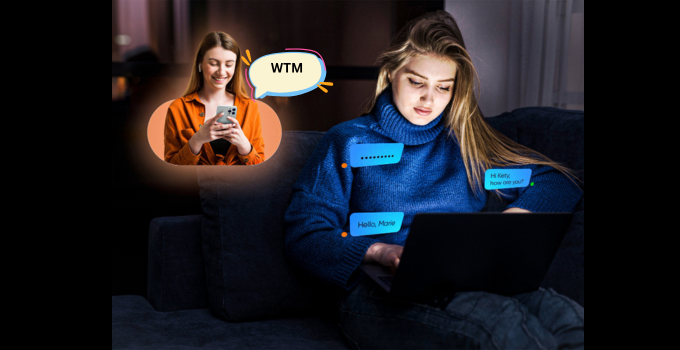The acronym WTW is used in texts and social media. It stands for "What's the Word?" or "What's Up?". WTW is a casual way to start a conversation or check in on someone. Texting acronyms like WTW are popular because they save time. They allow us to communicate more with fewer words.
Acronyms add personality and fun to conversations. Busy people use them to keep messages short. WTW and other acronyms reflect how we communicate today. Emojis and GIFs are also popular ways to communicate online. Acronyms like WTW and CFS are a new language for the internet. This internet language is inclusive and evolving. WTW can make conversations more efficient, expressive and engaging.
We will explain more about how to use WTW in digital conversations in this blog.
What Does WTW Mean?
WTW is an acronym used in messages. It stands for "What's the Word?" or "What's Up?" It's a relaxed way to say hello and start chatting.
How Do People Use WTW?
WTW can mean different things. It's often just a casual hello. But it can also ask "How are you?" or "What's new?" It depends on who you're talking to. With friends, WTW can be a fun conversation starter. If someone's been away, it shows you want to catch up. So this little acronym can have a big meaning!
The 3 Best Responses to WTW
Not sure what to say when someone texts you WTW? Don't worry! Here are three great ways to answer and keep the chat going.
Response 1: Casual and Informal
If you're talking with a friend, keep it easy and relaxed. Reply with something like "Not much, how about you?" It's a great way to say you're free to chat and also shows you care about what they're up to. This kind of answer keeps the conversation light and friendly.
Response 2: Humorous and Witty
Want to make the chat fun? Try a funny reply like "Just exploring the galaxy, you?" Using a joke or something silly is a good way to make the conversation more interesting. It can make the other person smile and shows your playful side. Plus, it can lead to a really fun and unexpected chat!
Response 3: Professional and Polite
If you're texting with someone from work or in a more serious setting, it's good to be a bit more formal. A polite answer like "All good here, thanks for asking!" works well. It shows you're happy to chat but keeps things professional. This kind of reply is respectful and shows you're keeping things business-like.
Evolution of WTW in Digital Communication
WTW isn't just a trend that comes and goes. It's part of how we talk online, and it's always changing. As we find new ways to chat and share online, WTW changes with us.
- WTW in Social Media
Have you noticed WTW on different social media sites? It's everywhere! Whether you're scrolling through Twitter, checking out stories on Instagram, or sending snaps on Snapchat, you'll see WTW. What's cool is how it changes a bit on each platform. On Twitter, WTW might be part of a quick, funny tweet. On Instagram, it could be in a comment asking about someone's latest photo. Each place uses WTW a little differently, but it always helps people connect and share.
- WTW in Professional Contexts
Now, this might surprise you: WTW isn't just for chats with friends. It's starting to show up in work emails and messages too. In places where everyone used to be very formal, a little bit of texting language is making things more friendly. It's like a quick handshake or a smile in a message. Using WTW and other acronyms can make talking at work feel more relaxed and can help everyone feel more connected. Just remember to use it wisely – you want to keep it professional!
Similar Texting Acronyms and Their Meanings
WTW is only one of many cool short forms we use when texting. There are lots more, each with its own special meaning. Let's look at some other popular ones.
1. BRB
BRB stands for "Be Right Back." It's super useful when you need to pause your chat for a bit. Maybe you're answering the door, grabbing a snack, or just need a moment. It's a quick way to let someone know you'll be back soon without having to explain.
2. LOL
LOL is a classic. It means "Laugh Out Loud." It's perfect for when something is really funny. Instead of just saying "that's funny," LOL adds a bit more feeling like you're laughing. It's great for making chats more fun and lively.
3. SMH
SMH means "Shaking My Head." Use this when you're just so amazed or can't believe something that words aren't enough. It's like a digital way of showing you're shaking your head in disbelief or frustration. SMH is good for those moments when you're speechless but still want to say something.
The Impact of Texting Language on Communication
The way we use words in texts and online messages is changing the whole game of how we talk to each other. This change is exciting, but it also has its ups and downs.
One big plus of texting language is how fast and easy it makes chatting. Imagine when you're in a hurry but want to stay in touch, a quick "BRB" or "LOL" keeps the conversation going without needing a long reply. It's like having a super-fast way to talk that still feels friendly and personal. This kind of language helps us stay connected, even when we're busy or far apart. It's like a bridge that keeps us close, no matter where we are.
But, there's a flip side. Sometimes, these short forms can cause confusion. Imagine you use an acronym like "SMH," thinking it's well-known, but the other person doesn't get it. They might take it the wrong way or feel left out of the loop.
It's important to remember that not everyone knows all these acronyms and the way we read a text can change based on our mood or the situation. So, it's good to be careful and make sure that the person you're chatting with understands your text language. That way, you can avoid mix-ups and keep your digital talks clear and fun!
WTW in Different Cultures
WTW isn't just something people use in one place; it's part of how people text all over the world. It's interesting to see how this little acronym crosses borders and oceans.
In English-speaking countries, WTW has its unique flavor. In the USA, it's a super casual way to start a chat. Over in the UK, it might come with a bit of British charm. Head down to Australia, and WTW could be mixed with some Aussie slang. Each place has its own way of using WTW, which makes it special. It's like a common word that everyone knows but uses in their own style.
But WTW isn't just an English thing. Around the world, different languages have their own versions. These acronyms are like WTW's cousins, serving the same purpose but in a way that fits each culture and language. For example, in Spanish, you might see "q tal?" which is short for "¿Qué tal?" (How are you?). In French, "cv" stands for "ça va" (How's it going?).
These short forms help people connect quickly and easily, no matter where they are or what language they speak. It shows how we all like to chat and stay in touch, using our own cultural twists to make it fun and familiar.
Conclusion
And there you have it – everything you need to know about WTW! It's not just a bunch of letters; it's a key to keeping in touch in our fast-moving online world. Whether you're firing off a message to a pal or touching base with a workmate, WTW and the ways you respond to it open up a whole world of chatting possibilities. Remember to keep it light, make sure it fits the situation, and most of all, have fun with it. Happy texting, everyone! Keep connecting, keep chatting, and let those acronyms fly!
FAQs
[wp-faq-schema]



